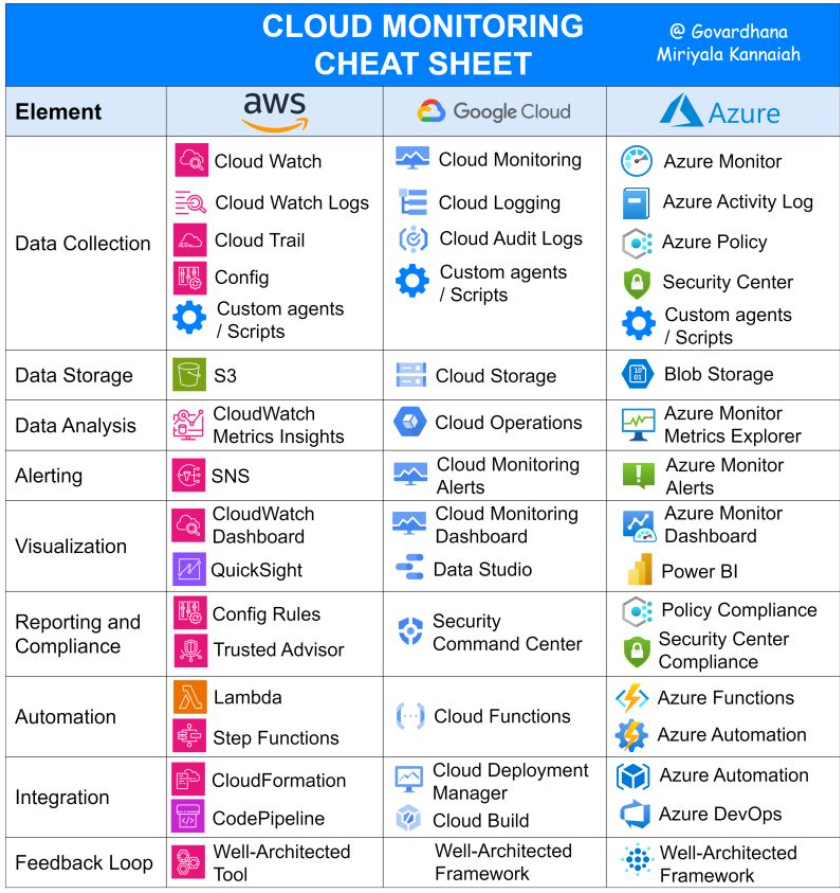
Cloud monitoring is the process of collecting and analyzing data about your cloud infrastructure and applications. This data can be used to identify and troubleshoot problems, optimize performance, and ensure that your cloud environment is secure.
All three major cloud providers offer cloud monitoring services:
- Amazon CloudWatch is a monitoring service that collects data from Amazon Web Services (AWS) resources, such as EC2 instances, EBS volumes, and RDS databases. CloudWatch can be used to monitor metrics, logs, and events.
- Google Cloud Monitoring is a monitoring service that collects data from Google Cloud Platform (GCP) resources, such as Compute Engine instances, Cloud Storage buckets, and Cloud SQL databases. Cloud Monitoring can be used to monitor metrics, logs, and traces.
- Azure Monitor is a monitoring service that collects data from Microsoft Azure resources, such as Azure VMs, Azure Storage accounts, and Azure SQL databases. Azure Monitor can be used to monitor metrics, logs, and alerts.
Each of these cloud monitoring services offers a variety of features, but they all have the following common capabilities:
- Metrics: Collect and store metrics about your cloud resources, such as CPU usage, memory usage, and disk I/O.
- Logs: Collect and store logs from your cloud resources, such as application logs, system logs, and security logs.
- Traces: Collect and store traces of requests as they flow through your cloud infrastructure.
- Alerts: Create alerts to notify you when your cloud resources are not performing as expected.
- Dashboards: Create dashboards to visualize your cloud monitoring data.
- Reporting: Generate reports to track the performance of your cloud environment over time.
The best cloud monitoring service for you will depend on your specific needs and requirements. If you are using AWS, then CloudWatch is a good option. If you are using GCP, then Cloud Monitoring is a good option. If you are using Azure, then Azure Monitor is a good option.
You can also use a third-party cloud monitoring service, such as Datadog or New Relic. These services offer a wider range of features and capabilities than the native cloud monitoring services, but they can be more expensive.
Here is a table comparing the key features of cloud monitoring on AWS, Google Cloud, and Azure:
| Feature | AWS CloudWatch | Google Cloud Monitoring | Azure Monitor |
|---|---|---|---|
| Metrics | Yes | Yes | Yes |
| Logs | Yes | Yes | Yes |
| Traces | Yes | Yes | Yes |
| Alerts | Yes | Yes | Yes |
| Dashboards | Yes | Yes | Yes |
| Reporting | Yes | Yes | Yes |
| Cost | Pay-as-you-go | Pay-as-you-go | Pay-as-you-go |
Amazon Web Services (AWS):
- Amazon CloudWatch: AWS CloudWatch is a comprehensive monitoring and observability service. It allows you to collect and track metrics, monitor log files, set alarms, and react to changes in your AWS resources. It covers services like EC2 instances, databases, Lambda functions, and more.
- Amazon CloudTrail: While not a direct monitoring service, CloudTrail records API calls made on your account, providing a detailed audit trail for actions taken. This helps with security and compliance monitoring.
Google Cloud Platform (GCP):
- Google Cloud Monitoring: Formerly known as Stackdriver, Google Cloud Monitoring lets you collect and analyze metrics, logs, and other performance data from various Google Cloud services. It also integrates with external monitoring tools and offers dashboards, alerts, and visualizations.
- Google Cloud Logging: This service lets you store, search, analyze, and visualize logs generated by your GCP resources. It can be integrated with Cloud Monitoring for a unified observability experience.
Microsoft Azure:
- Azure Monitor: Azure Monitor provides a comprehensive solution for collecting, analyzing, and acting on telemetry from Azure and non-Azure resources. It includes monitoring for applications, infrastructure, and network performance.
- Azure Log Analytics: This service allows you to collect, analyze, and act on telemetry and log data from your cloud and on-premises environments. It’s a powerful tool for troubleshooting and monitoring resource health.
- Azure Application Insights: Specifically designed for application performance monitoring, this service helps you identify and diagnose issues in your applications by collecting telemetry data from live applications.
I’m a DevOps/SRE/DevSecOps/Cloud Expert passionate about sharing knowledge and experiences. I am working at Cotocus. I blog tech insights at DevOps School, travel stories at Holiday Landmark, stock market tips at Stocks Mantra, health and fitness guidance at My Medic Plus, product reviews at I reviewed , and SEO strategies at Wizbrand.
Please find my social handles as below;
Rajesh Kumar Personal Website
Rajesh Kumar at YOUTUBE
Rajesh Kumar at INSTAGRAM
Rajesh Kumar at X
Rajesh Kumar at FACEBOOK
Rajesh Kumar at LINKEDIN
Rajesh Kumar at PINTEREST
Rajesh Kumar at QUORA
Rajesh Kumar at WIZBRAND

 Starting: 1st of Every Month
Starting: 1st of Every Month  +91 8409492687
+91 8409492687  Contact@DevOpsSchool.com
Contact@DevOpsSchool.com
